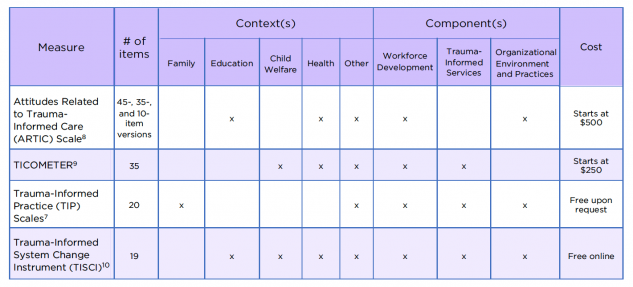October 1, 2019

Interest in trauma-informed approaches across child-serving systems has surged in the past two decades. This interest has largely been in response to research showing that most children experience at least one potentially traumatic event by the age of 17 years1, together with the strong relation between childhood trauma exposure and problems with health, mental health, and other concerns across the life span.2 Trauma-informed approaches integrate understanding of trauma throughout a program, organization, or system to enhance the quality and scope of services for those affected by trauma.3 However, there is a lack of research on how to measure and evaluate a trauma-informed approach. How do staff measure the extent to which a program, school, or organization is trauma-informed? How do managers/leaders know whether the trauma-informed efforts of their programs, schools, or organizations are effective in promoting thriving among children, families, and staff?
Although there is variation in how a “trauma-informed approach” is defined, one review4 identified 15 common components that can be organized into three categories. In order to determine whether an initiative is trauma-informed, it is important to assess these components:
Researchers from CHDI, the Yale School of Medicine, and the Medical University of South Carolina conducted a systematic review5 of measures (in particular, surveys) of a trauma-informed approach that were published between 1988 and 2018. Using specific search terms, the research team reviewed journal articles and websites for surveys that measured a systems-level, trauma-informed approach focused on addressing psychological trauma. The paper did not include trauma screening tools or diagnostic measures.
The systematic review includes 49 surveys of a trauma-informed approach. Characteristics of each survey were identified and summarized, including length, relevant context, components of a trauma-informed approach assessed, research support, and cost. Whereas some of the surveys were applicable to a wide range of contexts, others were developed to assess policies and practices within specific settings. Four examined approaches focused on improving family and other relational processes; 38 examined approaches in organizations, including schools and health settings; and seven assessed approaches that involved a whole community or service system. Forty-two of the surveys examined workforce development, 24 examined trauma-focused services, and/or 23 examined organizational environment and practices. Twelve surveys examined all three domains. In general, most surveys had little research support in regard to their development and application in practice. The team found only one study that examined whether survey scores (i.e., on the Trauma-Informed Practice Scales) were related to improvements in service recipients’ general health and well-being (e.g., self-efficacy).6,7 The remaining surveys varied in the extent to which they had research support. For instance, not all of the surveys had performance statistics; validity statistics reflect the extent to which a survey measures what it is intended to measure and reliability statistics indicate the extent to which a survey performs consistently. The best surveys should have evidence of both validity and reliability.
The table below includes information on four surveys from the review. These surveys were selected by the research team as promising tools for assessing a trauma-informed approach, each of which has some research support.

Measuring a trauma-informed approach can help to increase provider understanding of trauma, inform prioritization of implementation strategies, and be used to assess changes during implementation. As part of its efforts to help improve the quality of, and access to, children’s mental health services in Connecticut, CHDI has partnered with the Department of Children and Families (DCF) and the Court Support Services Division of the Judicial Branch in using the TISCI10 and similar measures to assess the degree to which child welfare and juvenile justice policies and procedures were trauma-informed and contributed to modifications of policies and practice guides to better address childhood trauma.
The following recommendations are for organizations, programs, or systems that are also interested in assessing the extent to which they are trauma-informed:
Measures (e.g., surveys) of a trauma-informed approach offer opportunities to examine whether programs, organizations, and broader service systems can support the health of those affected by trauma. Stakeholders need effective measures to identify their strengths and areas for improvement and to monitor their progress toward becoming trauma-informed. Although the larger review identified 49 promising surveys, more work is needed to provide a stronger evidence base, including developing reliable and valid surveys that are applicable across various service systems. In addition, research is needed to determine the extent to which changes in a trauma-informed approach contribute to improvements in child and family outcomes, which is the ultimate goal of a trauma-informed approach.
This Issue Brief was prepared by Robey B. Champine, PhD, MS, MPH, former Postdoctoral Fellow at CHDI and current Assistant Professor of Public Health at the Michigan State University College of Human Medicine; Ashley M. Nelson, Senior Data Analyst at CHDI; and Jason M. Lang, PhD, Vice President for Mental Health Initiatives at CHDI. For more information, contact Dr. Champine at champi74@msu.edu or visit www.chdi.org.
_____________________________
1Finkelhor, D., Turner, H. A., Shattuck, A., & Hamby, S. L. (2013). Violence, crime, and abuse exposure in a national sample of children and youth: an update. JAMA Pediatrics, 167(7), 614-621.
2Felitti, V. J., Anda, R. F., Nordenberg, D., Williamson, D. F., Spitz, A. M., Edwards, V., …Marks. J. S. (1998). Relationship of childhood abuse and household dysfunction to many of the leading causes of death in adults. The Adverse Childhood Experiences (ACE) Study. American Journal of Preventive Medicine, 14(4), 245-258.
3SAMHSA’s concept of trauma and guidance for a trauma-informed approach. (2014). Substance Abuse and Mental Health Services Administration. Retrieved from: https://store.samhsa.gov/shin/content/SMA14-4884/SMA14-4884.pdf
4Hanson, R. F., & Lang, J. (2016). A critical look at trauma-informed care among agencies and systems serving maltreated youth and their families. Child Maltreatment, 21(2), 95-100.
5Champine, R. B., Lang, J., Nelson, A. M., Hanson, R. F., & Tebes, J. K. (2019). Systems measures of a trauma-informed approach: A systematic review. American Journal of Community Psychology. (in press)
6Sullivan, C. M., Virden, T., Strom, J., Goodman, L. A., & Ramirez, R. (2018). Evaluation of the effects of receiving trauma-informed practices on domestic violence shelter residents. American Journal of Orthopsychiatry, 88(5), 563-570.
7Goodman, L. A., Sullivan, C. M., Serrata, J., Perilla, J., Wilson, J. M., Fauci, J. E., & DiGiovanni, C. D. (2016). Development and validation of the Trauma-Informed Practice Scales. Journal of Community Psychology, 44(6), 747-764.
8Baker, C. N., Brown, S. M., Wilcox, P. D., Overstreet, S., & Arora, P. (2016). Development and psychometric evaluation of the Attitudes Related to Trauma-Informed Care (ARTIC) Scale. School Mental Health, 8, 61-76.
9Bassuk, E. L., Unick, G. J., Paquette, K., & Richard, M. K. (2017). Developing an instrument to measure organizational trauma-informed care in human services: The TICOMETER. Psychology of Violence, 7(1), 150-157.
10Richardson, M. M., Coryn, C. L. S., Henry, J., Black-Pond, C., & Unrau, Y. (2012). Development and evaluation of the Trauma-Informed System Change Instrument: Factorial validity and implications for use. Child and Adolescent Social Work Journal, 29(3), 167-184.